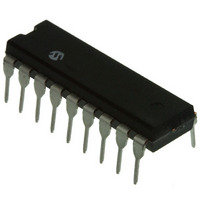PIC16C433-I/P Microchip Technology, PIC16C433-I/P Datasheet - Page 51

PIC16C433-I/P
Manufacturer Part Number
PIC16C433-I/P
Description
IC MCU CMOS 8BIT 10MHZ 2K 18-DIP
Manufacturer
Microchip Technology
Series
PIC® 16Cr
Specifications of PIC16C433-I/P
Core Processor
PIC
Core Size
8-Bit
Speed
10MHz
Connectivity
LIN (Local Interconnect Network)
Peripherals
POR, WDT
Number Of I /o
5
Program Memory Size
3.5KB (2K x 14)
Program Memory Type
OTP
Ram Size
128 x 8
Voltage - Supply (vcc/vdd)
4.5 V ~ 5.5 V
Data Converters
A/D 4x8b
Oscillator Type
Internal
Operating Temperature
-40°C ~ 85°C
Package / Case
18-DIP (0.300", 7.62mm)
For Use With
DVA16XP185 - ADAPTER DEVICE ICE 18DIP/SOICAC164030 - MODULE SKT PROMATEII 28DIP/SOICDVA16XP140 - ADAPTER DEVICE FOR MPLAB-ICE
Lead Free Status / RoHS Status
Contains lead / RoHS non-compliant
Eeprom Size
-
8.5
The A/D module can operate during SLEEP mode. This
requires that the A/D clock source be set to RC
(ADCS<1:0> = 11). When the RC clock source is
selected, the A/D module waits one instruction cycle
before starting the conversion. This allows the SLEEP
instruction to be executed, which eliminates all digital
switching noise from the conversion. When the conver-
sion is completed, the GO/DONE bit will be cleared,
and the result loaded into the ADRES Register. If the A/
D interrupt is enabled, the device will wake-up from
SLEEP. If the A/D interrupt is not enabled, the A/D mod-
ule will then be turned off, although the ADON bit will
remain set.
When the A/D clock source is another clock option (not
RC), a SLEEP instruction will cause the present conver-
sion to be aborted and the A/D module to be turned off,
though the ADON bit will remain set.
Turning off the A/D places the A/D module in its lowest
current consumption state.
8.6
The overall accuracy of the A/D is less than ± 1 LSb for
V
all accuracy includes offset error, full scale error and
integral error. The A/D converter is monotonic over the
full V
less when either the analog reference (V
than 5.0V, or when the analog reference (V
than V
The maximum pin leakage current is specified in the
Device Data Sheet electrical specification, parameter
#D060.
In systems where the device frequency is low, use of
the A/D RC clock is preferred. At moderate to high fre-
quencies, T
lator. T
≤ 8 µs for preferred operation. This is because T
when derived from T
phase clock transitions. This reduces, to a large extent,
the effects of digital switching noise. This is not possi-
ble with the RC derived clock. The loss of accuracy due
to digital switching noise can be significant if many I/O
pins are active.
In systems where the device will enter SLEEP mode
after the start of the A/D conversion, the RC clock
source selection is required. In this mode, the digital
noise from the modules in SLEEP is stopped. This
method gives high accuracy.
2002 Microchip Technology Inc.
DD
Note:
= 5V ± 10% and the analog V
DD
DD
AD
range. The resolution and accuracy may be
A/D Accuracy/Error
.
A/D Operation During SLEEP
must not violate the minimum and should be
For the A/D module to operate in SLEEP,
the A/D clock source must be set to RC
(ADCS<1:0> = 11). To perform an A/D
conversion in SLEEP, the GO/DONE bit
must be set, followed by the SLEEP
instruction.
AD
should be derived from the device oscil-
OSC
, is kept away from on-chip
REF
= V
DD
REF
. This over-
DD
) is less
) is less
Preliminary
AD
,
8.7
A device RESET forces all registers to their RESET
state. This forces the A/D module to be turned off, and
any conversion is aborted. The value that is in the
ADRES register is not modified for a RESET. The
ADRES register will contain unknown data after a
Power-on Reset.
8.8
If the input voltage exceeds the rail values (V
by greater than 0.2V, then the accuracy of the conver-
sion is out of specification.
An external RC filter is sometimes added for anti-
aliasing of the input signal. The R component should be
selected to ensure that the total source impedance is
kept under the 10 kΩ recommended specification. Any
external components connected (via hi-impedance) to
an analog input pin (capacitor, zener diode, etc.) should
have very little leakage current at the pin.
8.9
The ideal transfer function of the A/D converter is as
follows: the first transition occurs when the analog input
voltage (V
3).
FIGURE 8-3:
Note:
FEh
FFh
04h
03h
02h
01h
00h
Effects of a RESET
Connection Considerations
Transfer Function
AIN
For the PIC16C433, care must be taken
when using the GP4 pin in A/D conver-
sions due to its proximity to the OSC1 pin.
) is 1 LSb (or Analog V
A/D TRANSFER FUNCTION
Analog Input Voltage
PIC16C433
REF
DS41139B-page 49
/256) (Figure 8-
SS
or V
DD
)














